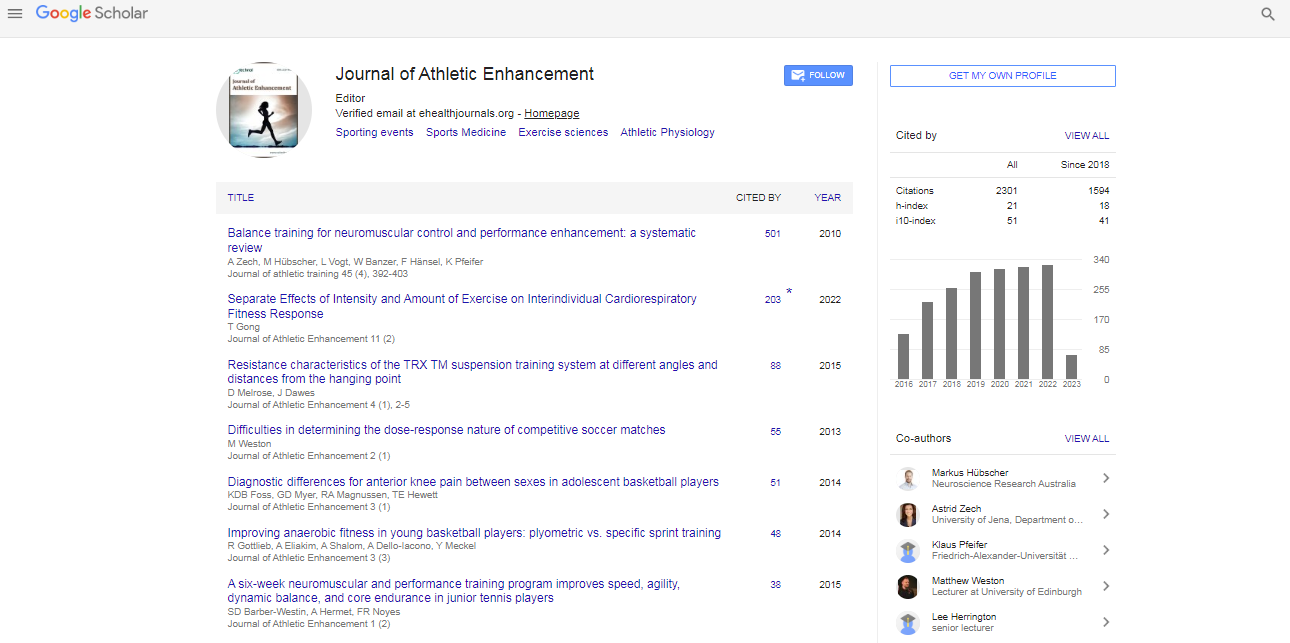Commentary, J Athl Enhanc Vol: 13 Issue: 2
Spinal Cord Injury in Sports: Risks, Prevention, and Rehabilitation
Zhang Rezaei*
1Department of Sports and Health, Nanchang Institute of Science and Technology, Nanchang, China
*Corresponding Author: Zhang Rezaei,
Department of Sports and Health,
Nanchang Institute of Science and Technology, Nanchang, China
E-mail: rezaeizhang@edu.cn
Received date: 26 February, 2024, Manuscript No. JAE-24-134556;
Editor assigned date: 29 February, 2024, PreQC No. JAE-24-134556 (PQ);
Reviewed date: 14 March, 2024, QC No. JAE-24-134556;
Revised date: 21 March, 2024, Manuscript No. JAE-24-134556 (R);
Published date: 28 March, 2024, DOI: 10.4172/2324-9080.1000114
Citation: Rezaei Z (2024) Spinal Cord Injury in Sports: Risks, Prevention, and Rehabilitation. J Athl Enhance 13:2.
Description
In the adrenaline-fueled world of sports, athletes often push their bodies to the limits in pursuit of victory. However, this pursuit of excellence can sometimes lead to serious injuries, including Spinal Cord Injuries (SCI). SCI in sports is a significant concern due to its potential for life-altering consequences.
The spinal cord serves as an important pathway for transmitting signals between the brain and the rest of the body. When the spinal cord experiences trauma, it can disrupt these communication pathways, leading to partial or complete loss of sensation and motor function below the injury site. In sports, SCI typically occurs as a result of high-impact collisions, falls, or sudden movements that place excessive stress on the spine.
Common causes of SCI in sports
High-velocity impacts: Sports such as football, rugby, and ice hockey involve high-speed collisions between players, increasing the risk of spinal cord injuries, particularly when proper protective gear is not worn.
Improper technique: Inadequate training or improper execution of techniques can predispose athletes to spinal injuries. For instance, diving headfirst in swimming or improperly tackling in football can result in catastrophic spinal cord trauma.
Overuse injuries: While not as acute as traumatic injuries, overuse injuries in sports like gymnastics, tennis, and weightlifting can gradually damage the spine, leading to chronic conditions such as herniated discs or spinal stenosis, which may eventually cause SCI.
Prevention strategies
Education: Athletes, coaches, and trainers should receive comprehensive education on proper techniques, injury recognition, and the importance of adhering to safety protocols.
Protective equipment: Wearing appropriate protective gear, such as helmets and neck braces, can mitigate the risk of SCI in contact sports by cushioning impacts and stabilizing the cervical spine.
Rule enforcement: Sports organizations and governing bodies should enforce strict rules regarding player conduct and implement penalties for dangerous plays that increase the likelihood of spinal injuries.
Strength and conditioning: Incorporating strength and conditioning programs tailored to enhance core stability and spinal strength can fortify athletes' bodies against the forces encountered during sports activities.
Injury surveillance: Regular monitoring of athletes for signs of spinal injury, such as neck pain, numbness, or weakness, can facilitate early intervention and prevent the exacerbation of minor injuries into more severe SCI.
Rehabilitation approaches
Multidisciplinary care: SCI rehabilitation typically involves a multidisciplinary team comprising physiatrists, physical therapists, occupational therapists, and psychologists who collaborate to address the physical, functional, and psychological aspects of recovery.
Early mobilization: Initiating rehabilitation interventions as soon as medically feasible helps prevent secondary complications such as muscle atrophy, contractures, and pressure ulcers while promoting neurological recovery.
Assistive devices: Mobility aids such as wheelchairs, braces, and walkers assist individuals with SCI in maintaining independence and participating in daily activities.
Functional training: Rehabilitation programs focus on improving functional abilities such as mobility, self-care skills, and adaptive techniques to maximize independence and quality of life.
Psychological support: Coping with the psychological impact of SCI, including depression, anxiety, and adjustment disorders, is an integral component of rehabilitation, necessitating counseling, support groups, and psychiatric interventions.
Spinal cord injury in sports represents a multifaceted challenge, encompassing the realms of injury prevention, acute management, and long-term rehabilitation. By adopting comprehensive strategies that prioritize education, safety, and early intervention, stakeholders in the sports community can mitigate the incidence and severity of SCI while promoting the health and well-being of athletes. Moreover, on-going research and advancements in medical technology offer hope for improved outcomes and enhanced quality of life for individuals affected by spinal cord injuries in sports.
 Spanish
Spanish  Chinese
Chinese  Russian
Russian  German
German  French
French  Japanese
Japanese  Portuguese
Portuguese  Hindi
Hindi 
